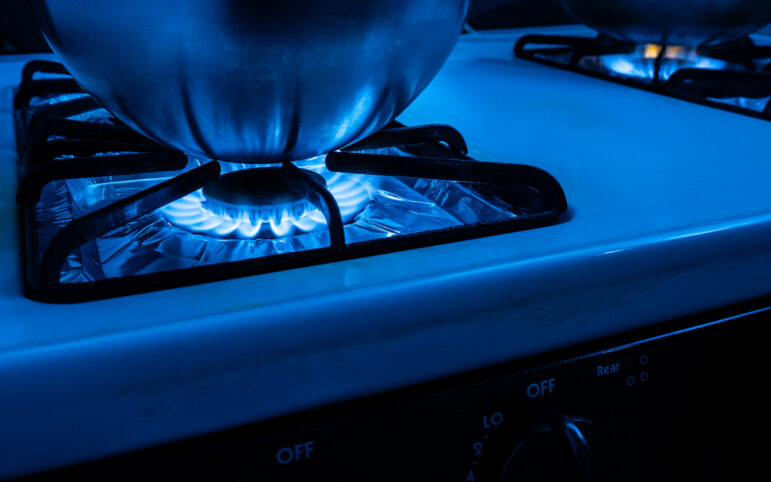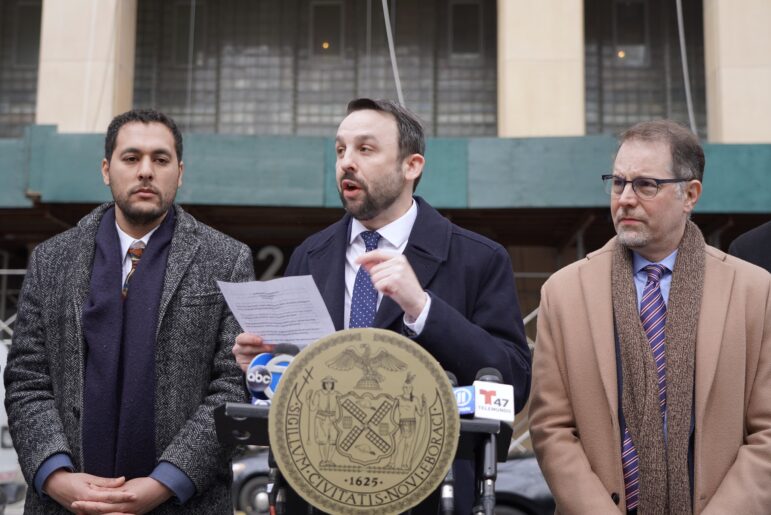
Michael Appleton/Mayoral Photography Office
Mayor de Blasio on the train earlier Friday.
The news that Mayor de Blasio has ended his presidential campaign was not a big shock. But it does raise a big question: Does de Blasio have the vision and political capital to make the remaining 833 days of his mayoralty worth the $591,000 the taxpayers will pay him for his services over that span?
Like just about everything the mayor does, his decision to quit the race will surely be greeted with derision by de Blasio’s many haters. The rest of us might just shrug or roll our eyes. The quixotic nature of de Blasio’s bid—and the rather important day job he back-burnered to undertake it—qualifies him for some mockery.
The fact is, however, he will soon have plenty of company on the sidelines. Raise your hand if you think Julian Castro is going to still be running come Thanksgiving. What are the odds on Amy Klobuchar being an active candidate by Christmas? Ten bucks says Cory Booker is not in the mix by the time New Hampshire Democrats vote. It’s math: Only one of the 10 people on that debate stage last week is going to be the nominee. Everyone else is guaranteed to be drafting a valedictory letter to donors, probably before Memorial Day.
It’s hard to say that de Blasio’s effort was a failure because it was never clear what the goal was. Compared with the other no-chance-in-hell 2020 campaigns—Hickenlooper, Bullock, Delaney, Swalwell, Inslee, Gillibrand—de Blasio almost ran a credible race, aided by his prominence as mayor of the Big Apple. He raised a little money (some of it problematic). He stole a little spotlight in the first of the two national debates in which he participated. He got face time with George Stephanopolous and Sean Hannity. He generated a couple decent policy ideas, like his international workers’ bill of rights and the robot tax; the latter actually drew some welcome attention to the threat that automation poses to U.S. workers. That’s more than some long-shot candidates will get to put in their campaign scrapbook. Because of the mayor’s low national standing, the risk of degrading his profile was minimal, and he avoided significant tarnish.
Where there was damage was at home, where de Blasio’s candidacy reinforced the notion that he wasn’t exactly devoting every iota of energy to running New York. Things might have been different for de Blasio in 2020 if he’d not sought the national spotlight so early in his first term, and instead waited until now to try to make a broader case. But the truth is there’s never a good time to run for president when you are mayor of the largest city in the country. That was true for Mike Bloomberg, who devoted attention to running for national office at more than one point during his time in City Hall, and for the current mayor. De Blasio’s day job was his calling card in the race—he had experience, he had delivered, et cetera—but it was also the biggest reason not to run. We needed our mayor here.
Well, now we’ve got him. Barring some deus ex machina plot twist, de Blasio today begins the end of his political career. Let us take stock of what he carries into that endgame. He enjoys very little goodwill among the media or the political class or activists. But he still has tremendous executive power and enough popularity in some communities (his approval rating in April was 42 percent overall, but 66 percent among Black New Yorkers) to convert, with some savvy, into political juice as the 2020 and 2021 election seasons arrive.
Most of all, he’s got nothing to lose. That means he might be able to take on noble, difficult causes that others can’t touch. Here are four things he could focus on:
Attacking school segregation: The report released last month by the city’s School Diversity Advisory Group presents a vision that goes way beyond changing the SHSAT or scrapping Gifted & Talented. It’s founded on a conclusion that the school system is riddled with inequalities that put every parent and child into a desperate fight for decent options—a fight that, for most, will end in failure and that, for all, doesn’t reflect the latest research on what makes for “good” schooling. It would be a rich irony if de Blasio, who is often compared unfavorably compared with Bloomberg when it comes to K-12 education, ended up putting the city on a path to address the deepest flaws in its school system.
Improving climate resiliency: De Blasio’s record on the environment has been far better than many expected back in 2013. But his achievements have largely been on the side of reducing the city’s carbon emissions, rather than protecting New York from the inevitable impacts of the climate change that is already baked in. Delays in flood maps and the Army Corps’ plans and the cost challenges for individual homeowners have stymied moves toward stronger coastal protection, or an honest conversation about retreat from some areas. Heat, fluvial flooding, the possibility of climate refugees—there’s a lot more than storm surge to prepare for. De Blasio could make resiliency a daily focus and drive agency attention and budgeting around it.
Retooling the housing plan: The mayor revamped his housing plan in 2017 and not long ago said there might be a bigger rethink in store. The critique of whether middle-income households need the help that de Blasio’s plan directs their way—or are willing to take the apartments set aside for them—still applies. The questions about whether affordable housing resources ought to be targeted more directly at the homelessness problem also persist. And the intersecting issues of homeownership, property taxes and senior housing all present policy challenges. The changes to the housing market across the city will comprise de Blasio’s most significant physical legacy. To the extent that the effort has been off target, the mayor has time to further correct it.
Fixing NYCHA: De Blasio inherited a public housing system in crisis. He responded with significant resources that were dwarfed by the scale of the problems, and his team applied a management strategy mismatched to the urgency of the situation. After federal investigations and resignations and settlements and billions in new city commitments, the mayor put forward a much more aggressive plan to save NYCHA. But moving 62,000 units to RAD, responsibly developing NYCHA land (ideally for senior housing) and other heavy lifts require hefty mayoral leadership. The safety of tenants and the survival of affordable housing are more important than de Blasio’s place in history, but he could end up being the mayor who, when finally awakened, saved public housing in New York.
* * * *
And heres’s No. 5. De Blasio has never shown much patience for the personal showmanship that is part of being mayor of New York. Ed Koch asked people how he was doing. Rudy Giuiani went to Yankee games and patrolled the city in his black Suburban until deep in the night. New Yorkers didn’t always love these mayors but they knew them. They had the sense that they lived in the same city as them. De Blasio doesn’t seem to do much of that.
De Blasio’s aversion to political optics deserves some respect, because there’s a heavy element of nonsense in them. But there’s an earnest part of them too, too: When they go jogging in the park or eat a hot dog on the boardwalk, mayors signal to New Yorkers that government is a human thing, not some bloodless machine, and that the people with power over their lives are people, too.
So, de Blasio could spend some of his remaining time doing more of those, like, mayor things. Some would be hokey (officiating at weddings in the municipal building), and others purely symbolic (go to the scenes of major fires). Some could be gimmicky (spend a night with a family in each of the city’s 59 community districts) and others very simple (ride the subway at least once a week). Not everyone will fall in love with him, but some will give him props for trying. And it might even be fun. It would be like he’s got the best job in America or something.
Bill de Blasio is never going to be president. But he is going to be a former mayor someday. And he has a little more than than 27 months to shape just what that legacy looks like, and the kind of city we get to live in when he’s gone.









One thought on “Analysis: Now What? 5 Things De Blasio Can Focus on Instead of the White House”
Add fixing the homeless issue. I regularly contact and provide photos to Dan Abramson Brooklyn Borough Director, Community Affairs Unit, and Shane Cox, Program Administrator at Street Homeless Solutions Division. The images document the persistent and on-going issues around the Dekalb Ave subway, nearby park, and Applebees. The park installed benches that enable people to sleep on them rather than sit. The seats exacerbated the situation by failing to include dividers. We deserve a safe and hospitable environment versus an area where people sleep and poop on the street.